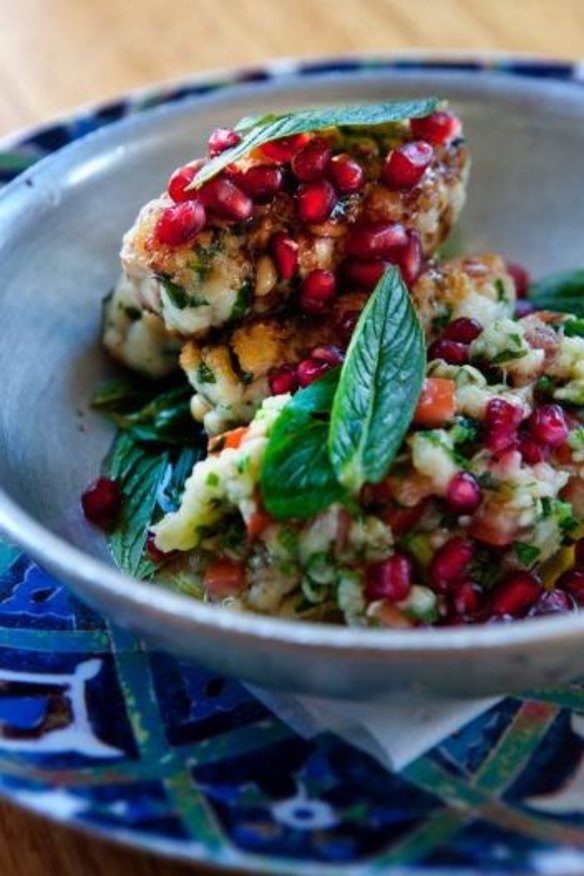How do you prepare a pomegranate?

What is the best way to prepare a pomegranate? K. Larsen
Delving into the etymological dictionary, it seems that pomegranate comes to us from the Old French pome grenade. Its scientific name was Malum granatum. Both the Old French and Latin mean "seeded apple". Take the pomegranate with the base in the palm of your hand and a paring knife in the other. The protrusion, originally the calyx of the flower, should be facing up. With the tip of the knife deeply score a circle around the top of the fruit about five centimetres below the calyx. This should then peel off in one piece to reveal the inside of the pomegranate, which is divided into six or more segments by the white pith. Take the tip of the knife and cut the skin down along the line of pith to almost, but not quite, the bottom. You can make a further cut down along the skin along the pith and it can then be removed in one piece. The pomegranate should open to reveal wedges lined with beautiful, juicy little rubies of seeds.
Are pressure cookers still available or have they gone out of fashion? M. Franz
They were the must-have kitchen gadget of the mid 20th century, the Thermomix of their day: cast iron or aluminium pots with tight-fitting lids and rubber seals. As the temperature inside increased so did the air pressure, reaching about 15 pounds per square inch before the automatic valve kicked in, sending a stream of steam into kitchen accompanied by a sibilant hiss. Inside, the boiling point of water increased from 100C to 121C, rapidly reducing the cooking time of the contents. In Australia they were popular from the postwar period until about the late 1970s. The death knell for the pressure cooker was sounded by the ping of the microwave oven's bell. They didn't, however, go the way of the K-tel Blitzhacker, Slice-O-Matic or Hamburger Patti-Stacker, which are museum pieces occasionally found on eBay. Pressure cookers of one sort or another have remained popular in large kitchens. In places such as Madrid they never went out of fashion, being used every lunchtime to make callos, the classic stew of tripe and chickpeas. In Australia, pressure cookers are making a comeback with food-loving brides putting them on their wish lists. You can buy pressure cookers in large kitchenware stores, DJs and Myer.
I recently made a bucketful of Polish pickles but as I don't have a "cool dark cellar" like back in the old country, where else can I store them? B. Kolber
I was going to jokingly mention the name of one of Melbourne's hidden laneway restaurants where the staff are so cool they can chill beer by skin contact and the lighting is so dim you need echolocation, like a bat, to find the loo. Alas, it is partially owned by a litigation lawyer. A cellar is about 14C, a constant cool temperature perfect for slow lactic fermentation. My Korean relatives make kimchi in a pot they bury outside. They joke that this is partially to regulate the temperature but also to get the stench out of the house. Thermal mass and insulation is the key. If you don't want to dig a hole in the ground, consider wrapping the bucket in old cloths and surrounding the lot with newspaper. Perhaps wrap in blankets and place in the back of the linen closet. A mate of mine hangs his salamis in an old fridge in the garage.
Why is celeriac so damn expensive? J. McPhee
It takes 20 weeks to grow a celeriac. Carrots take about 12, a lettuce six weeks. Farmers need to get a return on their land. There are a lot of labour costs in celeriac because, unlike a lot of other root vegetables, they are all hand-harvested and need to be hand- trimmed and cleaned. At this time of the year the price shoots up, as celeriac is a winter vegetable and there are fewer being produced. I have seen prices of about $7 a piece but this should come down again at the end of winter.
Send your vexing culinary conundrums to brainfood@richardcornish.com.au or tweet to @Foodcornish
The best recipes from Australia's leading chefs straight to your inbox.
Sign up